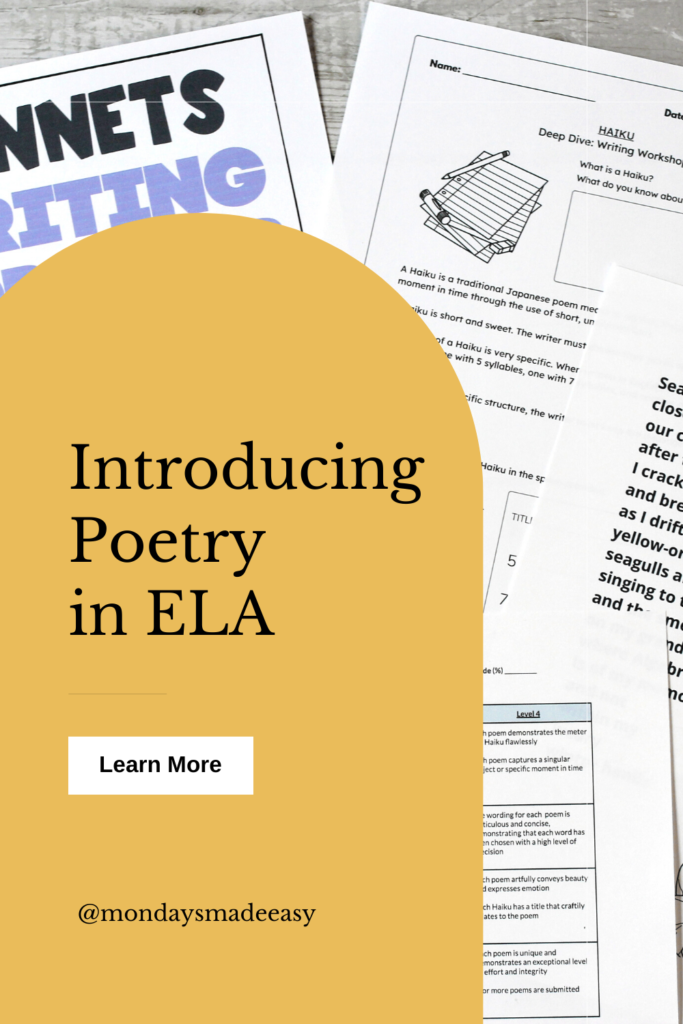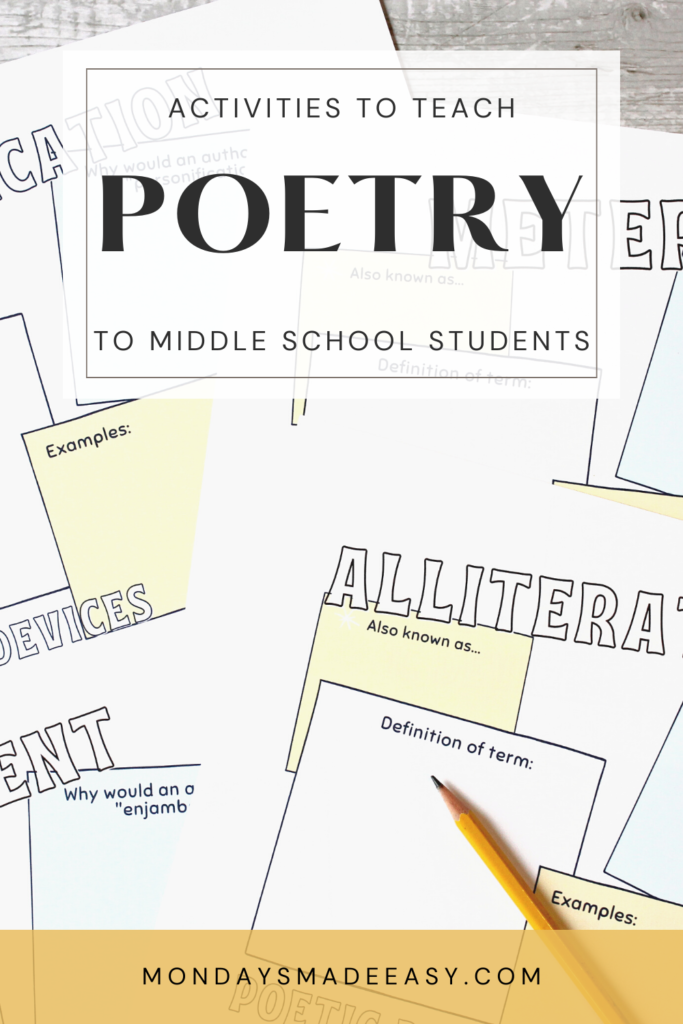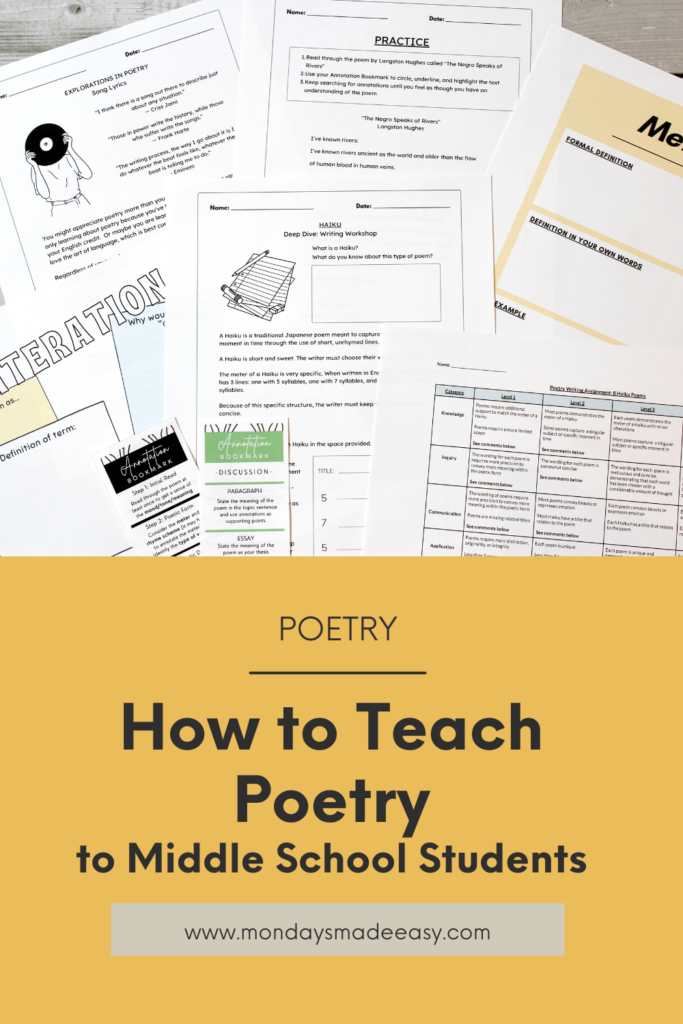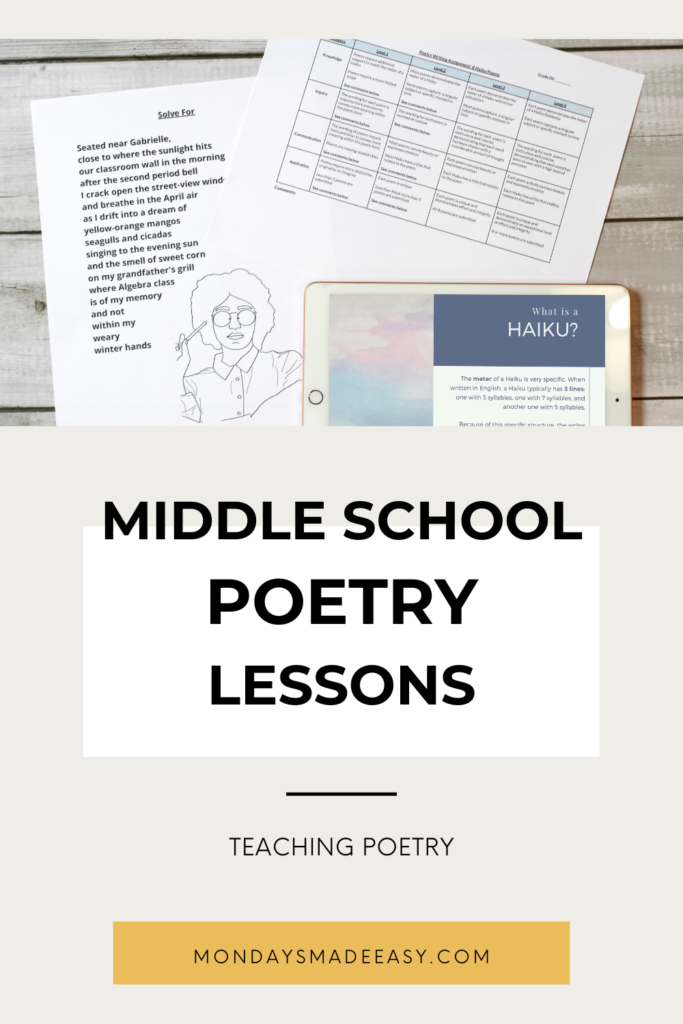Teaching poetry in middle school can be a truly enjoyable experience. Whether your students love poetry or want nothing to do with it – this blog post is for you! In this post, you’ll learn how you can inspire your students to love poetry. I’ll also share some activities and resources to make it exciting to teach poetry for middle school students.
What is the importance of teaching poetry?
Reading poetry is a great way to promote creative thinking in your classroom. Since poetry is so subjective, students have the opportunity to think outside the box. Poetry can also be highly beneficial to reluctant readers and writers because the shorter form of writing can be more accessible to them. It also allows students to see language in a new way.
Teaching poetry is also an enriching activity for English Language Learners. The meter of poetry helps language learners to become familiarized with the rhythm and sound of language. Reciting poetry out loud can also help with fluency.
How do you teach poetry in middle school?
You can start your middle school poetry unit by introducing the structural elements of poetry. These include key concepts like meter, rhythm, and verse. This lesson explores common poetic forms and solidifies students’ understanding of the elements of poetry. Students will be prompted to call forward their background knowledge of poetry from previous learning. They will also compare poetry to expository forms of writing to differentiate between the elements of poetry and other writing styles.
I also like to use a poetic device matching game as a fun way to familiarize students with essential terminology. These game cards showcase examples from both classic literature and contemporary song lyrics. By gamifying this lesson, you can motivate students to apply their knowledge in a fun and engaging way, thereby improving retention and teamwork skills
Another way to introduce poetry for middle school students is to make it more approachable by having students practice analysis on song lyrics. You can guide students through an exploration of central themes expressed in songs. This lesson will engage your students in a relevant exploration of themes in song lyrics from artists that they love.
What are the easiest poems to teach poetry for middle school students?
If your students have little experience with reading poetry, then you might be looking to start with the basics. Choosing accessible poems is a great way to introduce poetry for middle school students without overwhelming your students. You can use easier poems as a formative assessment of your students’ level of comfort with poetry.
This collection of easy poems for middle school includes classics from Robert Frost, Emily Dickenson, and Langston Hughes. If you are looking for poems based on a theme, this list includes 72 poems for middle school. You might also wish to explore some poems that might be familiar or relevant to students’ lives; “The Rose That Grew From Concrete” by Tupac Shakur or “Recitative” by A.E. Stallings are two great options.
How do you teach poetry analysis in middle school?
Before diving into poetry analysis, you might find it helpful to explicitly teach paraphrasing to your students. This is because poetry is very subjective. Before students explore figurative language or poetic devices, they will need to be able to translate poems into language that makes sense to them.
Since poetry is subjective, students need to feel confident in their ability to analyze it and make inferences. A great way to foster confidence is to start within their comfort zone. Music lyrics are a great opportunity for this. Students already have a lot to say about their favorite artists and songs; because of the cultural relevance of the music they enjoy, they often feel confident analyzing lyrics and searching for poetic devices in songs.
To make poetry for middle school students more engaging, there are several creative ways to spark critical thinking in your middle schoolers. One way is to assign a Canva Poetry Poster. This assignment guides students in creating a visual representation of the main ideas in any poem. It also engages students in a dynamic exploration of poetry’s visual aspects. By combining their artistic talents with literary analysis skills, students will deepen their understanding of poetry.
Making poetry fun in middle school
Your students will probably have the most fun writing their own poetry. If they are reluctant, you could start off with a few icebreakers or creative writing prompts to help them feel more expressive in your classroom.
Haiku poems are fantastic examples of poetry for middle school students. This is because the structure of a haiku is easy to replicate. In order to write a haiku, students will need to understand meter. Learning about meter is a great way to incorporate teachings on the sound and rhythm of the English language. This haiku writing workshop guides students through the history of haiku along with several examples to demonstrate this form. Students can then write their own series of haiku using the haiku templates provided.
Your students might enjoy replicating the styles of free verse poetry popularized on Instagram. If so, you can use this medium to engage them with poetry for middle schoolers and explore how it is relevant to popular culture. This lesson explores the Instapoetry community through an informative and interactive HyperDoc lesson. Students will also craft their own poems using the poetry writing workshop and Instagram template provided.
You can also lead a free verse poetry workshop to explore different forms of free verse poetry. This workshop includes a slideshow lesson on free verse poetry with examples from popular culture. It also prompts students to write their own free verse poems with the guidance of assignment instructions and a rubric. Students can choose between different styles of free verse poetry, including blackout poems, illustrative poems, and collage poems.
Poetry for middle school students: tying it all together
There are so many ways to make poetry for middle school students fun and engaging. I hope this blog post has helped you with a few lesson plans and activities to teach poetry in middle school. Your middle schoolers will definitely benefit from the creative thinking and expressive writing that poetry has to offer!








